
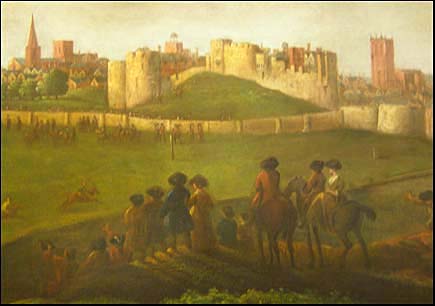 s
we leave the Old Dee Bridge and the roar of the weir behind us, we come
to a section of Chester's ancient city walls that has undergone considerable
changes over the centuries.
s
we leave the Old Dee Bridge and the roar of the weir behind us, we come
to a section of Chester's ancient city walls that has undergone considerable
changes over the centuries.
Without doubt this piece of high ground round which the River Dee sweeps in
a gradual curve has had strategic importance from earliest times, and around
the year 907AD, the Saxons of Mercia under Aethelfleda, as part of
their re-occupation of the old Roman fortress, erected a fortified base here
and incorporated it into their extension to the walls, to serve as part of
their defences against the Danes, then being driven out of Ireland and looking
for new lands to occupy.
Of
this
Saxon
fortress
no
trace
remains
and
very
little
more
is
known
of
the
site
until
the
winter
of
1069-70,
when
the
army
of Duke
William
of
Normandy came
to
Saxon
Chester,
which
became
the
last
remaining
great
town
in
England
to
fall
to
the
Conqueror's
sword
during
the
final
stages
of
the Harrying
of
the
North in
1069-70,
fully
three
years
after
the
Battle
of
Hastings.
Numerous rumours had long been circulating among the Norman army about the
bad roads, the position of the city- surrounded as it was by thick forests
and treacherous swamps- of its numerous inhabitants- and of their obstinate
courage and deadly familiarity with the longbow. Many of William's nobles, worn out by the struggles in the North,
and alarmed at these stories, demanded their discharge. Some actually retired
to Normandy, abandoning the lands with which they had already been rewarded;
but the persuasive powers of Duke William prevailed- he promised them great
rewards, and, as the conquest of Chester was the last of his projects, that
they would find rest after this one final victory.
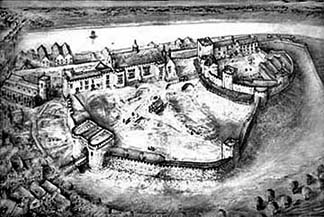 As it turned out, as the Norman army prevailed. The death toll during the campaign is believed to have been around 150,000, with substantial social, cultural, and economic damage. Due to the ruthless and violent "scorched earth" policy which the Normans employed, much of the land was laid waste and depopulated. In parts of the north, the damage was such that the survivors had to resort to cannibalism. Inevitably, plague followed. All told, about a fifth of the population of England may have died during the Norman Conquest. We know little about the battle for Chester or the number of casualties involved but we do know that a very large proportion of the houses in the town were destroyed.
As it turned out, as the Norman army prevailed. The death toll during the campaign is believed to have been around 150,000, with substantial social, cultural, and economic damage. Due to the ruthless and violent "scorched earth" policy which the Normans employed, much of the land was laid waste and depopulated. In parts of the north, the damage was such that the survivors had to resort to cannibalism. Inevitably, plague followed. All told, about a fifth of the population of England may have died during the Norman Conquest. We know little about the battle for Chester or the number of casualties involved but we do know that a very large proportion of the houses in the town were destroyed.
William
granted
the
Earldom
of
Chester
first
to Walter
de
Gherbaud-
who,
however
soon
returned
to
an easy life in Normandy-
and
then
to
his
nephew, Hugh
D'Avranches-
know
as Lupus (the
wolf)
but
in
later
life,
especially
by
the
Welsh,
as Hugh
Vras (Hugh the Fat) - "To
hold
to
him
and
his
heirs
as
freely
by
the
sword
as
the
King
holds
the
Crown
of
England".
The
Earldom
became
very
powerful
and
virtually
independent
of
the
Crown,
the
Earl
having
his
own
Parliament
consisting
of
eight
of
his
chosen
Barons
and
their
tenants,
and
they
were
in
no
way
bound
by
any
laws
passed
by
the
English
Parliament
with
the
exception
of
that
of
treason.
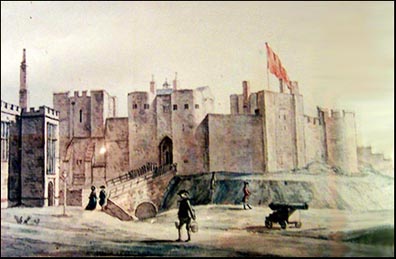 Hugh erected a typical Norman timber motte and bailey castle here which was
soon rebuilt in enduring stone. Of the fate of the Saxon stronghold formerly occupying
the site we know nothing at all, but its Norman successor over the course
of centuries grew into a formidable defensive structure of great strategic
importance.
Hugh erected a typical Norman timber motte and bailey castle here which was
soon rebuilt in enduring stone. Of the fate of the Saxon stronghold formerly occupying
the site we know nothing at all, but its Norman successor over the course
of centuries grew into a formidable defensive structure of great strategic
importance.
Following the Crown's annexation of the Earldom of Chester in 1237, when the
last Norman Earl died without issue, considerable enlargement and strengthening
were carried out by Henry III and Edward I, particularly in the outer bailey,
where the pallisade was replaced by a great stone wall in 1247-51.
Chester
Castle
was
the
frontier
base
from
which
North
Wales
was
attacked
and
eventually
conquered
in
the
12th
and
13th
centuries
and
the
exchequer,
courts
and
prison
were
based
here,
as
well
as
housing
the
garrison.
In 1246, Owen ap Gruffydd (Owain Gwynneth) escaped from imprisonment here to join his
brother Llewelyn in the fight against the English, under whose leadership
in 1257 they "ravaged the country to the very gates of the city".
In 1276-7 Edward came twice to Chester to summon Llewellyn to make peace,
but was each time refused, on the grounds that the Prince of Wales "feared
for his safety", whereupon the King laid siege to Rhuddlan Castle, where Llewellyn
was starved into submission.
In
1397,
it
is
recorded
that
the
Deputy
Constable
of
Chester Castle,
Thomas
le
Wodeward,
took
delivery
of
certain
new
supplies:
• 11 iron collars and 2 gross of iron chain.
• 2 pairs of iron belts with shackles
• 2 pairs of iron handcuffs with 4 iron shackles
• 7 pairs of iron feet fetters with 3 shackles
• 1 hasp for the stocks
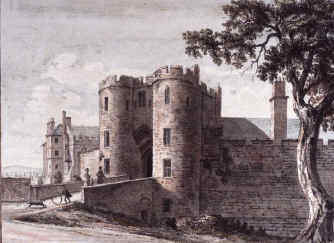 In 1399 Henry Bolingbroke, Duke of Lancaster, took Chester, soon after
mustering his troops under the walls and marching against Richard II, whom
he took at Flint Castle. He returned to Chester with the unfortunate monarch
(dressed in the monk's robe in which he had attempted to escape) and the Earl
of Salisbury "mounted on two little white nagges not worth 40 francs" and
lodged them in the Castle. After resting in a tower over the outer gateway,
they were escorted to Westminster. Bolingbroke deposed Richard- who was murdered
in prison the following year- and was elected King Henry IV by Parliament.
In 1399 Henry Bolingbroke, Duke of Lancaster, took Chester, soon after
mustering his troops under the walls and marching against Richard II, whom
he took at Flint Castle. He returned to Chester with the unfortunate monarch
(dressed in the monk's robe in which he had attempted to escape) and the Earl
of Salisbury "mounted on two little white nagges not worth 40 francs" and
lodged them in the Castle. After resting in a tower over the outer gateway,
they were escorted to Westminster. Bolingbroke deposed Richard- who was murdered
in prison the following year- and was elected King Henry IV by Parliament.
These
great
events
were,
of
course,
immortalised
by
Shakespeare,
and John
Speed commented
of
Richard, "If
to
spare
his
people's
bloud
he
was
contented
so
tamely
to
quit
his
royall
right,
this
fact
doth
not
only
seeme
excusable,
but
glorious;
but
men
rather
think
that
it
was
sloth,
and
a
vaine
trust
in
dissimulation
which
his
enemies
had
long
since
discovered
in
him".
After
centuries
of
service
(from
the
Saxons
to
the
20th
century
Edwardians,
architects
built
for
ever,
not
for
mere
decades
as
now)
Chester
Castle
sustained
serious
damage
during
the
Civil
War,
and
by
the
18th
century
had
been
allowed
to
fall
into
a
state
of
advanced
decay.
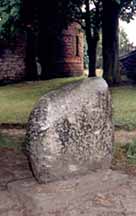 After
the
war, Oliver
Cromwell had
ordered
many
castles-
such
as
that
at
nearby Liverpool-
to
be
partially
or
completely
demolished
so
they
could
not
be
used
to
wage
war
again,
but
here
at
Chester
the
least
damaged
parts
of
the
building
continued
in
use;
writing
of
Chester
Castle
in
the Vale
Royal
of
England in
1651, Daniel
King recorded
that, "The
castle
is
a
place
having
priviledge
of
itself,
and
hath
a
Constable...
At
the
first
coming
in
is
the
Gate-house,
which
is
a
prison
for
the
whole
County,
having
divers
rooms
and
lodgings.
And
hard
within
the
Gate
is
a
house,
which
was
sometime
the Exchequer but
now
the Custom
House. Not
far
from
thence
in
the
Base
Court
is
a
deep
well,
and thereby
stables,
and
other
Houses
of
Office.
On
the
left-hand
is
a
chappell;
and
hard
by
adjoyning
thereunto,
the
goodly
fair
and
large
Shire-Hall
newly
repaired;
where
all
matters
of
Law
touching
the County
Palatine are
heard,
and
judicially
determined.
And
at
the
end
thereof
the
brave New
Exchequer,
for
the
said County
Palatine. All
these
are
in
the
Base
Court. Then
there
is
a
Draw-Bridge
into
the
Inner
Ward,
wherein
are
divers
goodly
Lodgings
for
the
Justices,
when
they
come:
And
herein
the
Constable
himself
dwelleth. The
Thieves
and
Fellons
are
arraigned
in
the
said
Shire-Hall;
and,
being
condemned,
are
by
the
Constable
of
the
Castle,
or
his
Deputy,
delivered
to
the
Sheriffs
of
the
City,
a
certain
distance
without
the
Castle-Gate,
at
a
stone
called The
Glovers
Stone from
which
place,
the
said
Sheriffs
convey
them
to
the
place
of
execution,
called Boughton"
After
the
war, Oliver
Cromwell had
ordered
many
castles-
such
as
that
at
nearby Liverpool-
to
be
partially
or
completely
demolished
so
they
could
not
be
used
to
wage
war
again,
but
here
at
Chester
the
least
damaged
parts
of
the
building
continued
in
use;
writing
of
Chester
Castle
in
the Vale
Royal
of
England in
1651, Daniel
King recorded
that, "The
castle
is
a
place
having
priviledge
of
itself,
and
hath
a
Constable...
At
the
first
coming
in
is
the
Gate-house,
which
is
a
prison
for
the
whole
County,
having
divers
rooms
and
lodgings.
And
hard
within
the
Gate
is
a
house,
which
was
sometime
the Exchequer but
now
the Custom
House. Not
far
from
thence
in
the
Base
Court
is
a
deep
well,
and thereby
stables,
and
other
Houses
of
Office.
On
the
left-hand
is
a
chappell;
and
hard
by
adjoyning
thereunto,
the
goodly
fair
and
large
Shire-Hall
newly
repaired;
where
all
matters
of
Law
touching
the County
Palatine are
heard,
and
judicially
determined.
And
at
the
end
thereof
the
brave New
Exchequer,
for
the
said County
Palatine. All
these
are
in
the
Base
Court. Then
there
is
a
Draw-Bridge
into
the
Inner
Ward,
wherein
are
divers
goodly
Lodgings
for
the
Justices,
when
they
come:
And
herein
the
Constable
himself
dwelleth. The
Thieves
and
Fellons
are
arraigned
in
the
said
Shire-Hall;
and,
being
condemned,
are
by
the
Constable
of
the
Castle,
or
his
Deputy,
delivered
to
the
Sheriffs
of
the
City,
a
certain
distance
without
the
Castle-Gate,
at
a
stone
called The
Glovers
Stone from
which
place,
the
said
Sheriffs
convey
them
to
the
place
of
execution,
called Boughton"
Another
source
records
that
that
criminals
were
handed
over "at Glovers
Stoune to
such
officer
of
the
Cittie
of
Chester,
in
and
from
hence
to
whipp
them
through
the
Cittie".
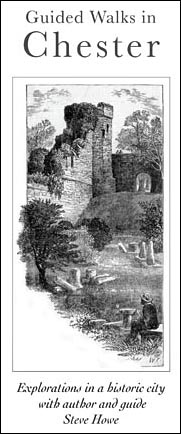 In
the
years
since,
what is conjectured to be the
old
Glovers Stone
which
long
marked
the
boundary
of
this
'no-man's-land'
between
the
authorities
of
Crown
and
City
outside
the
Castle
gateway
was
moved
to
a
small
garden
area
under
the
city
walls
and
close
to
the Watertower,
where
it
may
still
be
seen
today.
In
the
years
since,
what is conjectured to be the
old
Glovers Stone
which
long
marked
the
boundary
of
this
'no-man's-land'
between
the
authorities
of
Crown
and
City
outside
the
Castle
gateway
was
moved
to
a
small
garden
area
under
the
city
walls
and
close
to
the Watertower,
where
it
may
still
be
seen
today.
In
1696,
a
mint
was
set
up
at
Chester
Castle.
This
was
part
of
an
effort
to
completely
renew
the
nation's
currency,
and
the
man
in
charge
in
London
was
one Isaac
Newton (later
knighted
for
these
efforts,
but
not
for
his
science).
To
take
charge
of
the
Chester
mint
he
appointed
the
great
astronomer Edmund
Halley (he
of
comet
fame),
who
spent
two
years
here.
The
site
of
the
mint
is
marked
on
signs
put
up
by
English
Heritage,
just
behind
the
Half
Moon
Tower-
and
you
can
read
some
of
Halley's
reminisciences
of
his
time
in
Chester here.
Today,
incidentally,
Britain's
currency-
and
also
the
coinage
and
banknotes
of
many
other
countries-
is
produced
at
only
one
location,
the
Royal
Mint
at
Pontyclun,
South
Wales.
The
two watercolours
above
by Moses
Griffith (1747-1819)
shows
Chester
Castle
as
it
appeared
around
1750,
thirty-odd
years
before
its
almost
total
demolition
and
rebuilding-
as
does
the
fine
modern
drawing
higher up the page
by David
Vale.
When
we
view
the
magnificent
remains
of Conwy
Castle and
the
other
great
Edwardian
strongholds
of
neighbouring
North
Wales,
it
is
easy
to
feel
a
great
regret
that
more
of
the
ancient
fabric
of
Chester
Castle
was
not
allowed
to
survive
to
the
present
day.
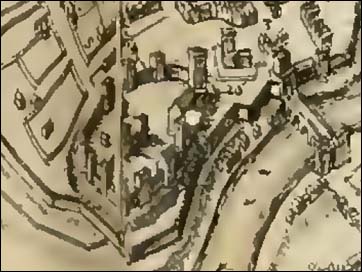 In
the
illustration,
you
can
see
across
the
outer
bailey
to
the
great
outer
gateway,
built
around
1292,
whose
two
tall
half-drum
towers
flanked
a
drawbridge
across
a
moat
cut
more
than
eight
metres
below
the
modern
surface. On
the
left
is
the
Great
Hall
or Shire
Hall of
1250-3
(rebuilt
in
1579-81)
which
housed
the
courts
of
the
justices
of
the
county
and
at
its
south
end
was
located
the
Exchequer
Court
of
the
County
Palatine
of
Chester.
It
was
here,
on
3rd
February
1646
that
the
citizens
of
Chester
completed
the
capitulation
of
their
city
to
Parliament
after
a
long
and
bloody
siege.
In
the
illustration,
you
can
see
across
the
outer
bailey
to
the
great
outer
gateway,
built
around
1292,
whose
two
tall
half-drum
towers
flanked
a
drawbridge
across
a
moat
cut
more
than
eight
metres
below
the
modern
surface. On
the
left
is
the
Great
Hall
or Shire
Hall of
1250-3
(rebuilt
in
1579-81)
which
housed
the
courts
of
the
justices
of
the
county
and
at
its
south
end
was
located
the
Exchequer
Court
of
the
County
Palatine
of
Chester.
It
was
here,
on
3rd
February
1646
that
the
citizens
of
Chester
completed
the
capitulation
of
their
city
to
Parliament
after
a
long
and
bloody
siege.
Right: Chester Castle as recorded in pen-and-ink in Daniel King's 'Vale Royal of England', 1656, a decade after the end of the Civil War. St. Mary's Church, the old Bridgegate and the now-vanished fortifications on the southern end of the Old Dee Bridge are also clearly visible.
We
can
also
see
the
church
of St. Mary-on-the-Hill (a
Norman
foundation,
rebuilt in the 16th century and restored
by
Harrison
in
1861-2,
and
again
by
Seddon
in
1891)
on
the
far
left
and
above
it
the Old
Dee
Bridge crosses
the
River
Dee,
much
as
it
continues
to
do
to
this
day. The church is also known as St. Mary-Within-the-Walls to distinguish it from
the first church to be built on the other side of the river, St. Mary-Without-the-Walls in Handbridge, whose fine tall spire is clearly visible from all around. Built in 1887, occupying a site of a Roman cemetery, it was a gift to the city from the Duke of Westminster.
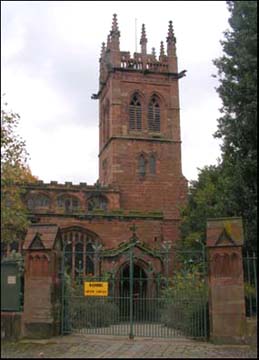 St. Mary-Within-the-Walls, however, has a far more reaching history. The original church on the spot, dating from the early 12th century, was known as St. Mary de Castro ('of the Castle'). The porch of present structure contains stones brought from the nunnery of St. Mary's, which once stood overlooking the Roodee where the unsightly Police HQ building is now. The tower was once much lower than it is today- as a precaution against attack it was forbidden for any neighbouring building to overlook the walls of the Castle. The ornately-carved upper parts of the tower we see today were added by the castle's re-builder, Thomas Harrison in the middle of the 19th century. The interior of the church is very fine and boasts a splendid English oak inner roof, brought from Basingwerk Abbey (whose picturesque ruins still survive near Holywell in North Wales) when that establishment was dissolved by the agents of King Henry VIII. Many of Chester's greatest citizens were buried here and some of their monuments are likely to surprise the visitor, being as they are painted in bright colours. The church was deconsecrated in 1972 and today hosts an education centre operated by Cheshire County Council.
St. Mary-Within-the-Walls, however, has a far more reaching history. The original church on the spot, dating from the early 12th century, was known as St. Mary de Castro ('of the Castle'). The porch of present structure contains stones brought from the nunnery of St. Mary's, which once stood overlooking the Roodee where the unsightly Police HQ building is now. The tower was once much lower than it is today- as a precaution against attack it was forbidden for any neighbouring building to overlook the walls of the Castle. The ornately-carved upper parts of the tower we see today were added by the castle's re-builder, Thomas Harrison in the middle of the 19th century. The interior of the church is very fine and boasts a splendid English oak inner roof, brought from Basingwerk Abbey (whose picturesque ruins still survive near Holywell in North Wales) when that establishment was dissolved by the agents of King Henry VIII. Many of Chester's greatest citizens were buried here and some of their monuments are likely to surprise the visitor, being as they are painted in bright colours. The church was deconsecrated in 1972 and today hosts an education centre operated by Cheshire County Council.
In the 18th century, a remarkable event in early avaition history occured at Chester Castle, which was recorded the year after its undertaking by the ‘pilot’, Thomas Baldwin, in his book, AIROPAIDIA: Containing the Narrative of a BALLOON EXCURSION from CHESTER.
He wrote, “On Thursday, the 8th of September, 1785, at six in the morning, one of the cannons (a six-pounder] was first fired in the Castle yard, to inform the city and neighbourhood that the necessary preparations were making to inflate the balloon. At xii the cannon fired a second time, to announce that the process was in a proper degree of forwardness.
Before half-past one, Mr. Lunardi had inflated his balloon in the finest manner; and at 40 minutes past one, the Balloon having a levity which not less than 20 pounds weight would counterpoise, Mr. Baldwin was liberated by the hands of Mr. Lunardi, who suffered no one to approach the car.
The car first landed at 28 minutes past three, in a field belonging to a farm called Bellair, in the Township of Kingsley, near two miles east by south from the Town of Frodsham, and twelve from Chester. He landed exactly at 7 minutes before four, near the middle of Rixton Moss; and on his return to Chester the following day he was met by the Militia Band and ushered with loud huzzas into his native city.”
This historic event took place less than two years after the world's first manned flight, that of the Montgolfier Brothers' balloon in Paris on 21st November 1783.
Around
1780,
100
years
after
the Vale
Royal entry
was
written,
the
old
stones
of
the
medieval
Chester
Castle
were
swept
away
to
make
room
for
the
buildings
we
see
today. This
great
complex
of
Shire
Hall,
courts,
prison,
armoury
and
barracks
was
designed,
after
winning
a
competition-
and
a
prize
of
50
guineas-
by Thomas
Harrison-
then
a
relatively
obscure
architect
with
very
few
buildings
to
his
name-
and
were
erected
between
the
years
1785
and
1822.
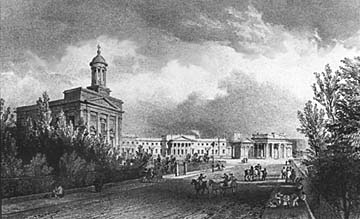 Harrison
(1744-1829)
was
born
in
Richmond,
Yorkshire,
the
son
of
a
joiner.
His
early
talent
for
mechanics,
mathematics
and
drawing
won
him
the
patronage
of
a
local
nobleman,
who
sent
him
on
that
essential
experience
in
the
education
of
a
privileged
young
man
of
the
day-
the
Grand
Tour
of
Italy,
where-
despite
having
no
formal
architectural
training-
he
gained
a
reputation
based
upon
his
designs
for
a
number
of
buildings
in
Rome-
although
none
were
actually
built.
Harrison
(1744-1829)
was
born
in
Richmond,
Yorkshire,
the
son
of
a
joiner.
His
early
talent
for
mechanics,
mathematics
and
drawing
won
him
the
patronage
of
a
local
nobleman,
who
sent
him
on
that
essential
experience
in
the
education
of
a
privileged
young
man
of
the
day-
the
Grand
Tour
of
Italy,
where-
despite
having
no
formal
architectural
training-
he
gained
a
reputation
based
upon
his
designs
for
a
number
of
buildings
in
Rome-
although
none
were
actually
built.
Upon
returning
to
England,
Harrison
worked
on
a
few
minor
architectural
commissions
before
winning
the
Chester
competition
at
the
age
of
40.
The
commission
was
originally
just
for
a
new
gaol
(see
next
page)
but
was
later
extended
to
cover
the
rebuilding
of
the
medieval
Shire
Hall-
unfortunately
for
us:
by
all
accounts
it
had
been
a
most
beautiful
and
impressive
building-
and
in
1804,
extended
again
to
include
new
barracks
and
armoury
blocks.
When
completed,
the
complex
covered
a
much
larger
area
than
the
old
Castle,
extending
well
beyond
the
medieval
curtain
walls.
To
complete
his
scheme,
Harrison
designed
an
impressive
new
entrance
in
the
Greek
Doric
style,
which
was
erected
between
1810
and
1822,
a
free-standing
structure
similar
to
Berlin's
famous
Brandenburg
Gate-
built
about
twenty
years
earlier-
and
said
to
be
based
on
the Propylaeum of
the
Acropolis
in
Athens.
The
centre
of
the
new
legal
buildings
was
the Assize
Court with
its
massive
and
impressive
portico.
Each
of
its
twelve
Doric
columns
is
formed
from
one
single
stone
23
feet
in
height.
When
the
first
of
these
was
raised,
with
great
ceremony,
within
a
cavity in
the
plinth
was
placed
a
lead
box,
inside
which
was
a
small
Wedgewood
urn,
this
in
turn
containing
several
coins
of
the
day.
An
engraved
brass
plate
was
fastened
over
the
cavity
before
the
column
was
hauled
into
position.
 Due
to
the
court's
foundations
being
situated
over
the
old
moat
of
the
medieval
castle,
considerable
structural
cracking
occured
and
when
in
1920,
major
repairs
were
undertaken,
this
urn
was
found
together
with,
under
another
column,
a
small
brass
snuffbox
which
had
belonged
to
Admiral
Lord
Nelson,
which
also
contained
coins.
When
the
columns
were
re-erected
in
1922,
the
urn
was
replaced in
situ,
coins
dated
1921-22
having
been
added.
The
snuffbox,
however,
was
added
to
the
collection
of
Cheshire
Regimental
relics.
Due
to
the
court's
foundations
being
situated
over
the
old
moat
of
the
medieval
castle,
considerable
structural
cracking
occured
and
when
in
1920,
major
repairs
were
undertaken,
this
urn
was
found
together
with,
under
another
column,
a
small
brass
snuffbox
which
had
belonged
to
Admiral
Lord
Nelson,
which
also
contained
coins.
When
the
columns
were
re-erected
in
1922,
the
urn
was
replaced in
situ,
coins
dated
1921-22
having
been
added.
The
snuffbox,
however,
was
added
to
the
collection
of
Cheshire
Regimental
relics.
The
interior
of
the
court
was
built
in
a
semi-circle
with
twelve
Ionic
columns
as
supports.
Originally,
the
jury's
retiring
room
and
the
turnkey's
lodge
were
to
the
left
of
the
court,
as
was
also
the
entrance
to
the
cells,
the
lower
level
of
which
were
occupied
by
the
felons
and
the
upper
by
the
debtors.
The
upper
cells
survive
today
and
are
used
for
the
daily
housing
of
prisoners
awaiting
appearance
in
what
is
today Chester
Crown
Court.
Many
famous
trials
have
taken
place
here
over
the
years,
none
more
notorious
than
that
of
Brady
and
Hindley,
the
'Moors
Murderers' in 1966.
"Would you have me go to Chester and work there now? I don’t like the thoughts of it. If I go to Chester and work there, I can’t be my own man; I must work under a master, and perhaps he and I should quarrel, and when I quarrel I am apt to hit folks, and those that hit folks are sometimes sent to prison; I don’t like the thought either of going to Chester or to Chester prison. What do you think I could earn at Chester?"
Tinker: "A matter of eleven shillings a week, if anybody would employ you, which I don’t think they would with those hands of yours. But whether they would or not, if you are of a quarrelsome nature you must not go to Chester; you would be in the castle in no time". George Borrow: Lavengro (1851)
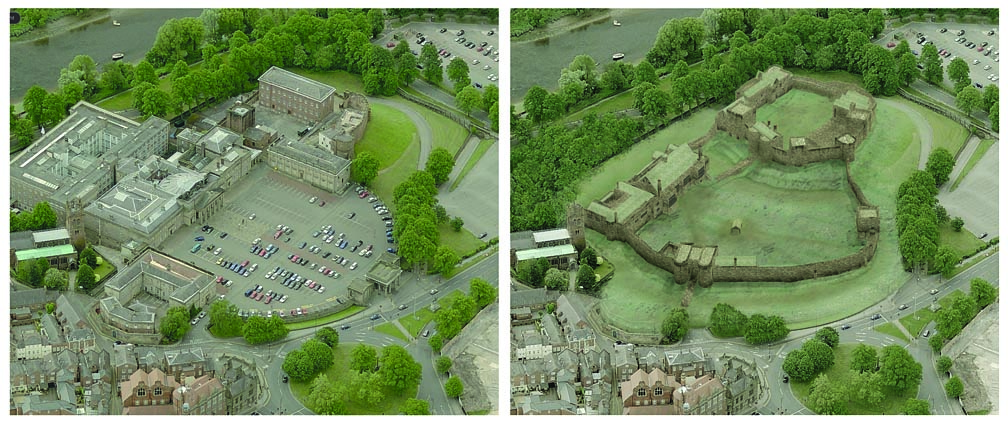
| Above left: Thomas Harrison's rebuilt castle as we see it today. Right: what we may still have if the rebuilding had not occured- an amazing recreation by Martin Moss of the medieval castle surrounded by the traffic and structures of modern Chester. The Castle features in another of Martin's works- a remarkable view of Chester from across the River Dee around the year 1750... |

Now
go
on
to part
II of
our
exploration
of
Chester
Castle...

 As it turned out, as the Norman army prevailed. The death toll during the campaign is believed to have been around 150,000, with substantial social, cultural, and economic damage. Due to the ruthless and violent "scorched earth" policy which the Normans employed, much of the land was laid waste and depopulated. In parts of the north, the damage was such that the survivors had to resort to cannibalism. Inevitably, plague followed. All told, about a fifth of the population of England may have died during the Norman Conquest. We know little about the battle for Chester or the number of casualties involved but we do know that a very large proportion of the houses in the town were destroyed.
As it turned out, as the Norman army prevailed. The death toll during the campaign is believed to have been around 150,000, with substantial social, cultural, and economic damage. Due to the ruthless and violent "scorched earth" policy which the Normans employed, much of the land was laid waste and depopulated. In parts of the north, the damage was such that the survivors had to resort to cannibalism. Inevitably, plague followed. All told, about a fifth of the population of England may have died during the Norman Conquest. We know little about the battle for Chester or the number of casualties involved but we do know that a very large proportion of the houses in the town were destroyed. Hugh erected a typical Norman timber
Hugh erected a typical Norman timber  In 1399
In 1399  After
the
war,
After
the
war, 
 In
the
illustration,
you
can
see
across
the
outer
bailey
to
the
great
outer
gateway,
built
around
1292,
whose
two
tall
half-drum
towers
flanked
a
drawbridge
across
a
moat
cut
more
than
eight
metres
below
the
modern
surface. On
the
left
is
the
Great
Hall
or Shire
Hall of
1250-3
(rebuilt
in
1579-81)
which
housed
the
courts
of
the
justices
of
the
county
and
at
its
south
end
was
located
the
Exchequer
Court
of
the
County
Palatine
of
Chester.
It
was
here,
on
3rd
February
1646
that
the
citizens
of
Chester
completed
the
capitulation
of
their
city
to
Parliament
after
a
long
and
bloody
siege.
In
the
illustration,
you
can
see
across
the
outer
bailey
to
the
great
outer
gateway,
built
around
1292,
whose
two
tall
half-drum
towers
flanked
a
drawbridge
across
a
moat
cut
more
than
eight
metres
below
the
modern
surface. On
the
left
is
the
Great
Hall
or Shire
Hall of
1250-3
(rebuilt
in
1579-81)
which
housed
the
courts
of
the
justices
of
the
county
and
at
its
south
end
was
located
the
Exchequer
Court
of
the
County
Palatine
of
Chester.
It
was
here,
on
3rd
February
1646
that
the
citizens
of
Chester
completed
the
capitulation
of
their
city
to
Parliament
after
a
long
and
bloody
siege. Harrison
(1744-1829)
was
born
in
Richmond,
Yorkshire,
the
son
of
a
joiner.
His
early
talent
for
mechanics,
mathematics
and
drawing
won
him
the
patronage
of
a
local
nobleman,
who
sent
him
on
that
essential
experience
in
the
education
of
a
privileged
young
man
of
the
day-
the
Grand
Tour
of
Italy,
where-
despite
having
no
formal
architectural
training-
he
gained
a
reputation
based
upon
his
designs
for
a
number
of
buildings
in
Rome-
although
none
were
actually
built.
Harrison
(1744-1829)
was
born
in
Richmond,
Yorkshire,
the
son
of
a
joiner.
His
early
talent
for
mechanics,
mathematics
and
drawing
won
him
the
patronage
of
a
local
nobleman,
who
sent
him
on
that
essential
experience
in
the
education
of
a
privileged
young
man
of
the
day-
the
Grand
Tour
of
Italy,
where-
despite
having
no
formal
architectural
training-
he
gained
a
reputation
based
upon
his
designs
for
a
number
of
buildings
in
Rome-
although
none
were
actually
built.

